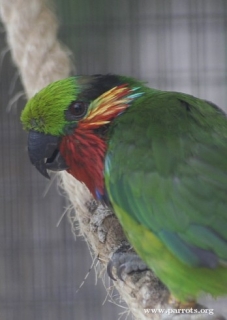Edward’s Fig Parrot |
|
|
Photos
View in GalleryDid You Know?
The Fig Parrot family needs vitamin K supplements to stay healthy, more than other families of parrots.Academic Research
Related publications: Psittaculirostris edwardsiiSpecies Profile
Genus: Psittaculirostris | Species: edwardsii
Size:
18cm (7 in)
Weight:
105g (3.7 oz)
Subspecies including nominate:
one
Colour Adult:
Male-yellow/green forehead and crown; olive/brown occiput merging into wide black band across nape of neck to eyes; red cheeks and throat; yellow ear coverts, with thin and elongated feathers variously mixed in and tipped with red and blue; blue/black band across upper breast; red central underparts from lower breast to upper abdomen; orange/red edged inner wing coverts; wide cream/yellow underwing stripes. Bill grey/black. Eye red. Female-as in male, but with wider breast band coloured dark blue; yellow/green lower breast to upper abdomen.
Colour Juvenile:
As in adult adult female but with yellow cheeks with variable red markings. Eye red/brown.
Call:
Calls made in flight are somewhat screechy; also emits sounds like coins dropping on concrete. Some notes staccato and abrupt.
Video Links:
Video 1 | Video 2More Information:
Content Sources:
CITES
BirdLife International
Cornell Lab of Ornithology/Birds of the World
Parrots: A Guide to Parrots of the World, Juniper and Parr, 1998
Parrots of the World, Forshaw, 2006. 2010 edition
Parrots in Aviculture, Low, 1992.
Parrots: Their Care and Aviculture, Low, 1986.
Photos
View in GalleryDid You Know?
The Fig Parrot family needs vitamin K supplements to stay healthy, more than other families of parrots.Academic Research
Related publications: Psittaculirostris edwardsiiSpecies Care
Captive Status:
Rare in aviculture.
Longevity:
Not recorded.
Housing:
Walk-in enclosure minimum length 2.1m (7 ft) or indoor aviary minimum length 1.8m (6 ft).
Diet:
Dried figs soaked in water for a few hours, two or more per bird daily with a drop of vitamin K additive; fruits such as: apple, pear, orange, banana, cactus fruits, pomegranate, forming at least 50 percent of the diet; soaked sultanas; berries (elder, mountain ash, pyracantha); spray millet; small seed mix such as: canary, oats, safflower and a little hemp; cooked pulses and beans; rearing food made from: hard-boiled egg, wholegrain bread and carrot all ground to crumbly consistency. Breeding diet: mealworms; commercial insectivorous food. Withhold seed for first three weeks of chick's lives.
Enrichment:
Vigorous chewers, so provide flowering, fir, pine and willow branches; wooden toys, vegetable tanned leather toys, heat sterilized pine cones.
Nest Box Size:
L-shaped box with base 5" x 10" (12.7cm x 25.4cm), height 5" (12.7cm).
Clutch Size:
2
Incubation Time:
25 days
Fledging Age:
8 weeks
Hatch Weight:
Not recorded.
Peak Weight:
Not recorded.
Weaning Weight:
Not recorded.
Photos
View in GalleryDid You Know?
The Fig Parrot family needs vitamin K supplements to stay healthy, more than other families of parrots.Academic Research
Related publications: Psittaculirostris edwardsiiSpecies Wild Status
World Population:
Unknown, stable.
IUCN Red List Status:
Least Concern
CITES Listing:
Appendix II
Threat Summary:
Not globally threatened. A BirdLife “restricted-range” species. Locally common to very common, with as many as 400 recorded in a single flock. A total of 2851 birds were exported by Indonesia between 1981 and 1990, which is not thought to cause significant declines; however, its commercial importation into Europe from Indonesia was banned in Nov 1987.
Range:
NE New Guinea, from Humboldt Bay, Irian Jaya, east to Huon Gulf, Papua New Guinea.
Habitat:
Found up to 800m (2624 ft) in humid lowland forest, partially cleared areas, forest edge as well as near human settlements.
Wild Diet:
Feeds on figs, fruits of casuarinas, nectar and possibly insects.
Ecology and Behaviour:
Are usually found in pairs or noisy groups. Flocks of up to 400 birds have been recorded in the tops of fruiting trees. Birds are quick moving, hanging upside down to reach food.
Clutch and Egg Size:
2 eggs
Breeding Season:
January-May. Nest is in small hollow in high tree.
Related Links:
Photos
View in GalleryDid You Know?
The Fig Parrot family needs vitamin K supplements to stay healthy, more than other families of parrots.Academic Research
Related publications: Psittaculirostris edwardsiiMembers Only Resources
Please log-in now to find more research, resources and tools.
Not a Member?
Find more great information:
Gain exclusive access to 600+ pages of additional research, seminars and podcasts, specialists to ask your toughest questions, and dozens of other fun resources - when you become a WPT member.
Join Today >>

































